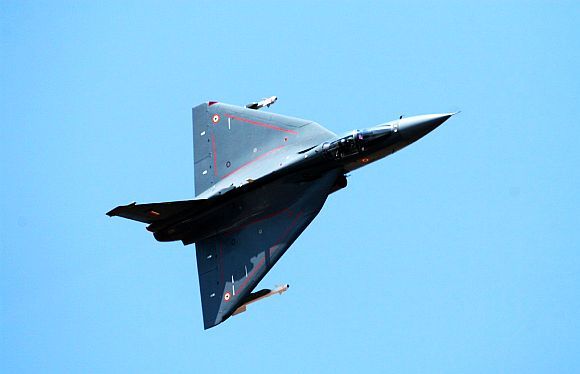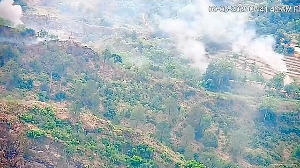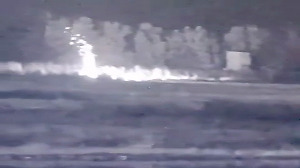 The end goal of defence procurement should be not import or indgenisation, but securing the country through able and ready armed forces, says Air Marshal P V Athawale (retd)
The end goal of defence procurement should be not import or indgenisation, but securing the country through able and ready armed forces, says Air Marshal P V Athawale (retd)
The maxim 'machines do not make things, humans do' is reflected in the status of indigenous defence manufacturing in India.
India's dubious distinction as the top global importer for defence purchases is not due to lack of technology, but predominantly due to lack of commitment and synergy of human effort.
Even so, the commitment from the government is most unequivocally visible today compared to the decades spent in rhetoric about promotion of Indian industry, especially the private sector.
While the commitment for action is strong, the progress will not be well directed unless we understand and resolve the conflict which paralyses us in the status quo.
Continual tinkering with Defence Procurement Procedures or thicker rulebooks look like solutions but result in little progress when there is no change in the way we think about the deadlock.
The world we have created is a process of our thinking. It cannot be changed without changing our thinking.
-- Albert Einstein
Indian Air Force acquisitions are major contributors towards India's standing among global arms importers. The examples and discussions hereon are, therefore, specific to the air force or military aviation requirements.
Dr Eliyahu M Goldratt put forward the Theory of Constraints (The Northern River Press, 1990) and proposed a wonderful method of working towards resolution of conflicts that restrict achievement of the goal. He articulated that non-achievement of goals in any system was due to a very small number of constraints (at least one constraint).
These, called core constraints, have usually been in existence for long and are intuitively well known. Many compromising solutions have possibly been implemented over and over again without success. A few examples of the compromising virtual solutions are:
- Compel the air force to buy Indian and not foreign equipment.
- Deny them technology, and they (the Defence Research and Development Organisation and defence public sector organisations) will make.
- We cannot go to a single private company -- let DRDO or DPSUs subcontract to private industry.
- A fatter rule book; write detailed DPPs.
- Air force telling Indian industry 'We support indigenisation; make excellent equipment and we will buy.'
Goldratt thought of the core problem as a dark black cloud and termed the method to a solution the 'Evaporating Clouds method.'
The need is to invent solutions where the problem won't exist. To find solutions, he emphasised on 'No Blames.'
When you blame others, you give up your power to change.
-- Robert Anthony
He explained that a problem existed only if in satisfying two positive requirements leading to the objective, the corresponding prerequisites (or actions) were in conflict. The requirements are genuine. However, to meet corresponding requirements, different departments perceive prerequisites (actions) differently depending upon their local measures.
The situation is depicted below:

In the context of the deadlock between actions for indigenous defence manufacturing, the conflict can be represented as shown below:

The solution begins with identifying assumptions that 'cloud' our minds and then 'evaporating' the cloud by verbalising and invalidating some of our assumptions while reinforcing others and then finding a solution that meets both the system requirements (B and C).
Some of the system requirements may also have to be reviewed. The budget is limited -- Our forces cannot possess all state-of-the-art platforms at any given time.
Indian Premier League cricket is the best example, where a franchise has to maximise its firepower within the given budget following the norms laid down for acquiring foreign players.
Similarly, it may be necessary to decide the minimum force level (acquisition) that can be indigenous, even if below par with globally top of the line; the follow up developments/upgrades must aspire to be state-of-the-art. The frontline needs, however, will have to be met with globally competitive platforms.
The answer lies in all parties coming together. Consequently, in the environment of trust that will develop, the air force may be assured that its acquisition needs for foreign purchase will not be jeopardised due to unrealistic timeframes of indigenous programmes.
It will be better prepared to accept indigenous effort. The conflict cloud is as shown below. Verbalising assumptions (some inappropriate and others valid) can indicate a solution to this dilemma. A few examples of assumptions that have been in existence for decades are indicated.

One more vital cloud needs to be dissipated -- the fear of private industry. Despite exciting discussions in seminars, nothing much has resulted about getting private industry's participation in a level playing field. The cloud is shown below.
The example of inappropriateness of one of the system's requirements is explained alongside. Examination of other assumptions can follow.
Indigenous design/development and defence manufacturing have unique challenges like a single user market and a single R&D agency -- the government. Industry, including the private sector, can grow only if the following measures are implemented:
- Until a 50 per cent satisfaction level, the armed forces are put in the driver's seat and accordingly measured for indigenisation. Industry will race ahead after that.
- Defence R&D is well supported by the armed forces (partnership in vital projects) with measurable targets for achievement by both.
- Defence PSUs are measured for performance predominantly by the amount of indigenous design/development and manufacture and not profits made through licensed manufacturing and support services.
- Defence manufacturing is made more assured and profitable for private industry.
Today's solution may not be relevant tomorrow. As the indigenous capability improves, a new force mix will have to be evolved and pursued. Strong indigenous industry exporting to friendly neighbours can further strengthen regional balance.
It is the hope that whatever the relevant solutions in the changing tomorrows, below par indigenous weapon systems will never have to be bought by the Indian armed forces.
Let us always remember that the end goal is not import or indeginisation but securing the country through able and ready armed forces.
IMAGE: India's homegrown Tejas fighter








